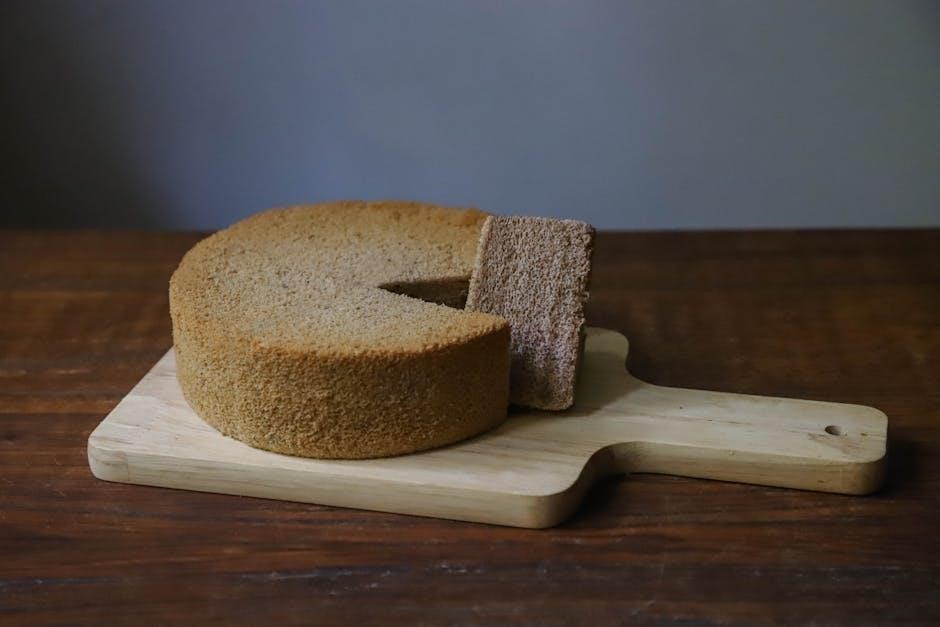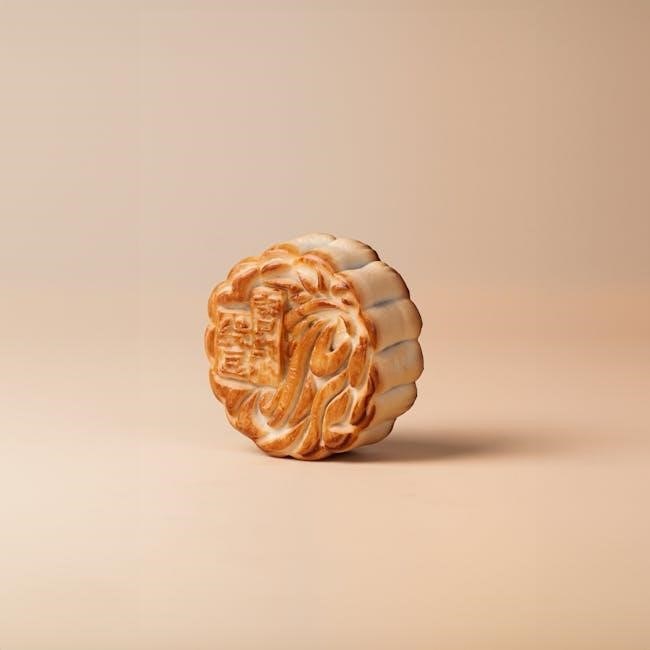Round cake cutting is an essential skill for events, ensuring equal portions and a polished presentation. Mastering techniques and using guides can enhance efficiency and visual appeal.
Importance of Proper Cake Cutting for Events
Proper cake cutting ensures even portions and a clean presentation, enhancing the overall event experience. It prevents messy slices and guarantees every guest receives a fair share. For weddings or gatherings, precise cutting reflects professionalism and attention to detail. Using the right techniques avoids crumbling or uneven sizes, maintaining the cake’s aesthetic appeal. Proper slicing also helps in managing serving sizes efficiently, making it easier to cater to the number of attendees. This ensures satisfaction and leaves a positive impression on your guests.
Overview of Tools and Techniques
Proper cake cutting requires the right tools and techniques to ensure clean, even slices. A serrated knife is essential for smooth cuts, while a cake stand allows easy rotation. Scoring the cake before cutting helps guide the knife, preventing uneven slices. Techniques like cutting from the center outward or dividing the cake into wedges ensure consistency. Using a serving tray to remove slices safely maintains presentation. These tools and methods streamline the process, making it efficient and visually appealing for any event or celebration.

Essential Tools and Preparation
A sharp serrated knife and a rotating cake stand are key tools for precise cutting. Remove decorations and score the cake to guide your knife, ensuring clean slices.
Recommended Knives for Cutting Round Cakes
A serrated bread knife or tomato knife is ideal for cutting round cakes, as they provide clean, even cuts. A sharp, long blade ensures precision and prevents the cake from tearing. For layer cakes, a serrated knife is preferred over a chef’s knife for smoother slicing. Soaking the knife in warm water before cutting can help glide through frosting and cake effortlessly. Always use a clean, sharp tool to achieve professional-looking slices and maintain the cake’s structure.
Removing Decorations and Preparing the Cake
Before cutting, remove all decorations, including ribbons, toppers, and dowels from tiered cakes. This ensures a smooth cutting process and prevents damage to the knife or cake. Place the cake on a stable surface and prepare a serving tray. Dried frosting can be gently scored with a knife to create a guide for even slicing. Ensuring the cake is at room temperature or slightly chilled can help maintain its structure during cutting, making the process more efficient and precise.
Step-by-Step Guide to Cutting a Round Cake
Master the art of slicing round cakes evenly with this guide. Start by making the first cut, then create consistent wedges, and remove slices safely for perfect serving.
Step 1: Making the Initial Cut
Begin by placing the cake on a stable surface and removing all decorations; Using a sharp serrated knife, start at the center and cut straight down through the cake to the bottom. This initial cut divides the cake into two equal halves, ensuring even distribution. For larger cakes, you may first score a line across the center to guide your knife. This step sets the foundation for creating uniform slices, making the rest of the cutting process more manageable and precise.
Step 2: Creating Even Wedges
After making the initial cut, rotate the cake 180 degrees and align the knife with the first cut to create a second slice directly opposite. Continue cutting evenly sized wedges by rotating the cake and slicing at consistent intervals. For larger cakes, use a serrated knife and a cake stand to ensure precision. This method ensures uniform portions and a clean presentation, making it ideal for events where consistency is key. Each wedge should be the same size for a professional finish.
Step 3: Removing Slices Safely
Once the wedges are cut, use a serrated knife or cake server to carefully slide under each slice. Gently lift and place the slice onto a serving tray or plate. For larger cakes, consider using a cake stand to rotate and access slices easily. Always clean the knife between cuts to prevent crumbs and frosting from spreading unevenly. This step ensures each slice is removed cleanly, maintaining the cake’s appearance and making serving efficient and stress-free for any event.

Different Methods for Cutting Round Cakes
Explore three versatile methods: cutting into even triangles, quarters for square pieces, or a mixed approach combining wedges and inner squares for varied presentations.
Method 1: Cutting Into Even Triangles
This method involves slicing the cake into identical triangular wedges, ensuring uniform portions. Start by scoring the cake’s center with a serrated knife, then make radial cuts from the center outwards, creating equal angles. For an 8-inch cake, aim for 8-10 slices. Rotate the cake after each cut to maintain evenness. Wipe the knife between cuts to prevent crumbs from transferring. This technique is ideal for events requiring consistent, visually appealing slices, making it a popular choice for weddings and gatherings.
Method 2: Cutting Into Quarters for Square Pieces
Cutting a round cake into quarters creates square or rectangular pieces, ideal for events requiring uniformity. Start by making two perpendicular cuts through the cake’s center, dividing it into four equal quarters. Score the top lightly before cutting to ensure accuracy. Use a serrated knife for clean cuts. Once divided, each quarter can be further sliced into smaller squares. This method is perfect for events where precise, symmetrical servings are desired, offering a modern twist on traditional cake cutting.
Method 3: Mixed Cutting (Wedges and Squares)
Mixed cutting combines round wedges and square pieces for visual variety. Start by cutting the cake into quarters, then slice the outer sections into wedges. The inner circle can be divided into smaller squares. This method is ideal for larger cakes, as it offers both uniform and varied servings. Use a serrated knife to ensure clean cuts, and score lines to guide precise slicing. This technique balances aesthetics and efficiency, making it perfect for events with diverse serving needs.
Serving Size Guide for Round Cakes
Determine serving sizes based on cake diameter. A 6-inch cake yields 5-6 slices, 8-inch offers 8-12 slices, and larger cakes provide more portions accordingly. Adjust sizes for events or smaller portions as needed.
Standard Serving Sizes by Cake Diameter
Standard serving sizes vary by cake diameter. A 6-inch cake typically yields 5-6 slices, while an 8-inch cake offers 8-12 slices. Larger cakes, such as 10-inch, provide 12-16 slices, and 12-inch cakes yield 20-24 slices. For precise cutting, mark the cake edge at equal intervals using a serrated knife. This ensures uniform portions and avoids uneven slices. Adjusting slice sizes allows flexibility for different events, making it easier to accommodate varying guest preferences and portion needs effectively.
Adjusting Slice Sizes for Different Events
Adjusting slice sizes ensures the right portion for any gathering. For weddings, smaller slices (1.5-2 inches wide) are ideal, while parties may prefer larger slices (2-2.5 inches). Use a serrated knife to score the cake before cutting, guiding precise adjustments. For tiered cakes, adjust slice width per layer. This flexibility ensures every event meets guest expectations, whether intimate or grand, by tailoring portions to the occasion’s needs without compromising presentation or flavor.

Tips for Presentation and Efficiency
For efficient cutting, use a serrated knife and a cake stand. Score the cake first to ensure clean cuts. Arrange slices neatly for an attractive presentation.
Presentation Ideas for Cut Cakes
Arrange cut slices neatly on a serving tray or cake stand for a clean, symmetrical display. Garnish with fresh flowers or berries for added elegance. Use a small amount of frosting to attach decorations to each slice. For tiered cakes, place smaller slices on lower tiers to create visual balance. Consider drizzling chocolate or caramel over the arranged slices for a polished finish. Ensure even spacing and alignment to maintain a professional presentation. These techniques enhance both the appeal and accessibility of your round cake.
Efficient Knife Techniques
Use a sharp serrated knife for clean cuts, as it reduces frosting smears. Warm the knife in water for smoother slicing. Start by scoring the cake’s center, then cut through gently; Rotate the cake after each slice to maintain balance. Wipe the knife between cuts to prevent crumbs from sticking. For larger cakes, cut inward 2 inches to create smaller, uniform slices. This method ensures even portions and a polished appearance. Practice these techniques to master the art of round cake cutting efficiently.
Additional Resources
Access printable guides, video tutorials, and serving charts for precise round cake cutting. Tools include diameter-based slice calculators and step-by-step instruction downloads for perfect results.
Printable Cake Cutting Guides
Downloadable guides provide visual aids for cutting round cakes into uniform servings. Available for various sizes, from 6-inch to 14-inch diameters, these templates ensure consistency and efficiency. They often include markings for different slice sizes, making it easy to achieve professional results. Printable guides are ideal for event planners, caterers, and home bakers, offering a practical solution to portion control and presentation. Use them alongside online calculators for precise measurements and stress-free cake serving.
Video Tutorials for Round Cake Cutting
Video tutorials offer step-by-step demonstrations for cutting round cakes evenly and efficiently. Platforms like YouTube feature expert-guided videos showing techniques like scoring, even slicing, and handling tiered cakes. These tutorials often cover methods for achieving uniform wedges or square pieces, ideal for events. Visual learners can benefit from seeing knife techniques in action, ensuring clean cuts and professional presentation. Many videos also address common challenges, like avoiding crumbs or smearing frosting, making them invaluable for beginners and experienced bakers alike. Pair with printable guides for flawless results.
